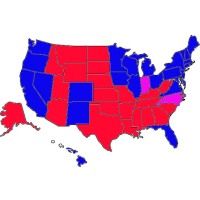U.S. Battleground States are at Record Low
 States have dug in, with only two (in pink) having budged in 2012 (graphic Steve Straehley, AllGov)
States have dug in, with only two (in pink) having budged in 2012 (graphic Steve Straehley, AllGov)
Once Republicans and Democrats figure out who their candidates will be for next year’s presidential contest, the campaign teams will likely be looking at a small map of the U.S. to figure out how to win the White House.
Getting enough electoral votes to win has really come down to besting the other party in so-called battleground states, where voters have a tendency to swing from Republican to Democrat, or vice versa, from one election to the next. The number of those states, however, is at an all-time low.
In the last four presidential elections (2000, 2004, 2008, 2012), 40 states plus the District of Columbia have voted for the same party’s candidate in every one of those contests. Only four states—Ohio, Virginia, Colorado and Nevada—have moved from solidly one party to the other. All four went Republican in 2000 and 2004 but were solidly Democratic in 2008 and 2012.
Dr. Eric Ostermeier of Smart Politics, after reviewing nearly 2,000 statewide votes for president across the last 46 elections since 1832, found “that the nation’s electoral maps are the most static they have been in history.”
Ostermeier noted that in 2012, only two states switched their support from the previous presidential election: North Carolina and Indiana, which went from backing Obama in 2008 to voting for Mitt Romney four years later.
-Noel Brinkerhoff
To Learn More:
Stasis: Presidential Electoral Maps Are in a Historic Holding Pattern (by Eric Ostermeier, Smart Politics)
List of United States Presidential Election Results by State (Wikipedia)
- Top Stories
- Unusual News
- Where is the Money Going?
- Controversies
- U.S. and the World
- Appointments and Resignations
- Latest News
- What If China Invaded the United States?
- Donald Trump Has a Mental Health Problem and It Has a Name
- Trump Goes on Renaming Frenzy
- Trump Deports JD Vance and His Wife
- Trump Offers to Return Alaska to Russia






Comments